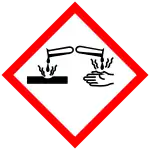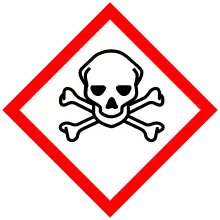| Names | |
|---|---|
| Preferred IUPAC name
N1,N6-Dibutylhexane-1,6-diamine | |
Other names
| |
| Identifiers | |
3D model (JSmol) |
|
| ChemSpider | |
| ECHA InfoCard | 100.023.106 |
| EC Number |
|
| MeSH | N,N'-dibutyl-1,6-hexanediamine |
PubChem CID |
|
| RTECS number |
|
| UNII | |
| UN number | 2735 |
CompTox Dashboard (EPA) |
|
| |
| |
| Properties | |
| C14H32N2 | |
| Molar mass | 228.424 g·mol−1 |
| Appearance | Colourless liquid |
| Density | 821 mg mL−1 |
| Boiling point | 131 to 133 °C (268 to 271 °F; 404 to 406 K) at 4 hPa |
Refractive index (nD) |
1.451 |
| Hazards | |
| GHS labelling: | |
  | |
| Danger | |
| H314, H330 | |
| P260, P280, P284, P305+P351+P338, P310 | |
| Flash point | 113 °C (235 °F; 386 K) |
| Related compounds | |
Related compounds |
|
Except where otherwise noted, data are given for materials in their standard state (at 25 °C [77 °F], 100 kPa).
Infobox references | |
N,N’-Dibutylhexamethylenediamine (dibutylhexanediamine) is a chemical compound used in the production of polymers. It is highly toxic upon inhalation,[1] and is listed as an extremely hazardous substance as defined by the U.S. Emergency Planning and Community Right-to-Know Act.
See also
References
- ↑ Kennedy Jr, GL; Chen, HC (1984). "Inhalation toxicity of dibutylhexamethylenediamine in rats". Food and Chemical Toxicology. 22 (6): 425–9. doi:10.1016/0278-6915(84)90324-7. PMID 6539732.
This article is issued from Wikipedia. The text is licensed under Creative Commons - Attribution - Sharealike. Additional terms may apply for the media files.